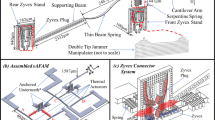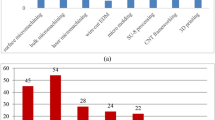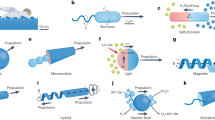Abstract
The use of mechanical bistable structures in the design of microrobots and mesorobots has many advantages especially for flexible robotic structures. However, depending on the used fabrication technology, the adequacy of theoretical and experimental mechanical behaviors can vary widely. In this paper, we present the manufacturing results of bistable structures made with two extensively used contemporary technologies: MEMS and FDM additive manufacturing. Key issues of these fabrication technologies are discussed in the context of microrobotics and mesorobotics applications.






















Similar content being viewed by others
References
Grossard M, Chaillet N, Régnier S (2013) Flexible robotics: applications to multiscale manipulations. Wiley
Chalvet V, Haddab Y, Lutz P (2013) A microfabricated planar digital microrobot for precise positioning based on bistable modules. IEEE - Trans Robot 29(3):641–649
Zaidi SSH, Cherfi-Boulanger Z, Lamarque F (2011) Contactless energy transfer and control strategy for bistable micro-actuator. University of Technology of Compiègne, Ph.D Thesis
Camescasse B (2013) Actionnements statique et dynamique dun mecanisme bistable: aspects modlisation, conception et exprimental, Ph.D. Thesis, Pierre and Marie University Curie
Cazottes P (2009) Actionnement des systemes bistables: modélisation et études expérimentales, Ph.D Thesis, Pierre and Marie University Curie
Pane IZ, Asano T (2008) Investigation on bistability and fabrication of bistable prestressed curved beam. Jpn J Appl Phys 47:52–91
Charlot B, Sun W, Yamashita K, Fujita H, Toshiyoshi H (2008) In-plane bistable nanowire for memory devices. In: Symposium on design, test, integration and packaging of MEMS/MOEMS. IEEE, pp 254–258
Park S, Hah D (2008) Pre-shaped buckled-beam actuators: theory and experiments. Sensors Actuators Phys 148(1):186–192
Qiu J, Lang J, Slocum A (2004) . A curved-beam bistable mechanism 13(2):137–146
Liao BT, Shen HH, Liao HH, Yang YJ (2009) A bi-stable 2x2 optical switch monolithically integrated with variable optical attenuators. Opt Express 17(22):19919–19925
Jensen BD, Parkinson MB, Kurabayashi K, Howell LL, Baker MS (2001) Design optimization of a fully-compliant bistable micromechanism. ASME Int Mech Eng Congress Exposition 48109:21–25
Hussein H, Chalvet V, Le Moal P, Bourbon G, Haddab Y, Lutz P (2014) Design optimization of bistable modules electrothermally actuated for digital microrobotics. In: IEEE/ASME International conference on advanced intelligent mechatronics AIM, pp 1273–1278
Gao R, Li M, Wang Q, Zhao J, Liu S (2018) A novel design method of bistable structures with required snap-through properties. Sensors Actuators A Phys 272:295–300
Vangbo M (1998) An analytical analysis of a compressed bistable buckled beam. Sensors Actuators A Phys 69(3):212–216
Chiao M, Lin L (2000) Self-buckling of micromachined beams under resistive heating. J Microelectromech Syst 9(1):146–151
Emam SA, Nayfeh AH (2004) On the nonlinear dynamics of a buckled beam subjected to a primary-resonance excitation. Nonlinear Dyn 35(1):1–17
Nayfeh AH, Emam SA (2008) Exact solution and stability of postbuckling configurations of beams. Nonlinear Dyn 54(4):395–408
Chen JS, Tsao HW (2013) Static snapping load of a hinged extensible elastica. Appl Math Model 37 (18–19):8401–8408
Hussein H, Le Moal P, Bourbon G, Haddab Y, Lutz P (2015) Modeling and stress analysis of a pre-shaped curved beam: influence of high modes of buckling. Int J Appl Mech 7(4):1550055
Krylov S, Dick N (2010) Dynamic stability of electrostatically actuated initially curved shallow micro beams. Contin Mech Thermodyn 22(6-8):445–468
Tajaddodianfar F, Yazdi MH, Pishkenari HN (2014) Dynamics of bistable initially curved shallow microbeams: effects of the electrostatic fringing fields. In: IEEE/ASME international conference on advanced intelligent mechatronics AIM, pp 1279–1283
Stoimenov BL, Rossiter JM, Mukai T (2007) Manufacturing of ionic polymer-metal composites (IPMCs) that can actuate into complex curves. Electroactive polymer actuators and devices (EAPAD). In: International society for optics and photonics, vol 6524
Timoshenko S (1961) Theory of elastic stability. McGraw-Hill
Chen Q, Haddab Y, Lutz P (2010) Microfabricated bistable module for digital microrobotics. J Micro-Nano Mechatron 6:1–12
Mohamed OA, Masood SH, Bhowmik JL (2015) Optimization of fused deposition modeling process parameters: a review of current research and future prospects. Adv Manuf 3(1):42–53
Ulu E, Korkmaz E, Yay K, Ozdoganlar OB, Kara LB (2015) Enhancing the structural performance of additively manufactured objects through build orientation optimization. J Mech Des 137(11):111410
Ion A, Wall L, Kovacs R, Baudisch P (2017) Digital mechanical metamaterials. In: The 2017 CHI conference on human factors in computing systems, pp 977–988
Ben Salem M, Aiche G, Rubbert L, Renaud P, Haddab Y (2018) Design of a microbiota sampling capsule using 3d-printed bistable. In: 40th IEEE international engineering in medicine and biology conference, pp 4868–4871
Hussein H, Le Moal P, Younis R, Bourbon G, Haddab Y, Lutz P (2019) On the design of a preshaped curved beam bistable mechanism. Mech Mach Theory 131:204–217
Hussein H (2015) Contribution to digital microrobotics: modeling, design and fabrication of curved beams, U-shaped actuators and multistable microrobots. Bourgogne Franche-Comté University, PhD thesis
Acknowledgments
This research is partially supported by the Investissements d’Avenir (Labex CAMI ANR-11-LABX-0004). The authors would like to thank Gilles Bourbon and Patrice Le Moal from FEMTO-ST Institute for their contributions to the simulation, the development of MEMS process and for microfabrication.
Author information
Authors and Affiliations
Corresponding author
Additional information
Publisher’s Note
Springer Nature remains neutral with regard to jurisdictional claims in published maps and institutional affiliations.
Rights and permissions
About this article
Cite this article
Ben Salem, M., Hussein, H., Aiche, G. et al. Characterization of bistable mechanisms for microrobotics and mesorobotics. J Micro-Bio Robot 15, 65–77 (2019). https://doi.org/10.1007/s12213-019-00113-3
Received:
Revised:
Accepted:
Published:
Issue Date:
DOI: https://doi.org/10.1007/s12213-019-00113-3




